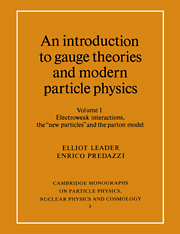Book contents
- Frontmatter
- Contents
- Preface
- Acknowledgements
- Notational conventions
- Note added in proof: the discovery of the top quark (?)
- Note added in proof: the demise of the SSC
- 1 Field theory and pre-gauge theory of weak interactions
- 2 The need for a gauge theory
- 3 Spontaneous symmetry breaking: the Goldstone theorem and the Higgs phenomenon
- 4 Construction of the standard model
- 5 Lowest order tests of the SM in the leptonic sector
- 6 The Higgs boson
- 7 The standard model beyond lowest order
- 8 e+e− physics and the standard model
- 9 Extension to the hadrons; quark–lepton universality
- 10 Phenomenology of semi-leptonic reactions
- 11 The discovery of the narrow vector resonances
- 12 Hidden flavour bound states
- 13 Open heavy flavours
- 14 The heavy lepton τ
- 15 Towards the parton model—deep inelastic scattering
- 16 The quark–parton model
- 17 Experimental tests of the quark-parton model
- Appendix 1 Elements of field theory
- Appendix 2 Feynman rules for QED, QCD and the SM
- Appendix 3 Conserved vector currents and their charges
- References
- Analytic subject index for vols. 1 and 2
4 - Construction of the standard model
Published online by Cambridge University Press: 19 March 2010
- Frontmatter
- Contents
- Preface
- Acknowledgements
- Notational conventions
- Note added in proof: the discovery of the top quark (?)
- Note added in proof: the demise of the SSC
- 1 Field theory and pre-gauge theory of weak interactions
- 2 The need for a gauge theory
- 3 Spontaneous symmetry breaking: the Goldstone theorem and the Higgs phenomenon
- 4 Construction of the standard model
- 5 Lowest order tests of the SM in the leptonic sector
- 6 The Higgs boson
- 7 The standard model beyond lowest order
- 8 e+e− physics and the standard model
- 9 Extension to the hadrons; quark–lepton universality
- 10 Phenomenology of semi-leptonic reactions
- 11 The discovery of the narrow vector resonances
- 12 Hidden flavour bound states
- 13 Open heavy flavours
- 14 The heavy lepton τ
- 15 Towards the parton model—deep inelastic scattering
- 16 The quark–parton model
- 17 Experimental tests of the quark-parton model
- Appendix 1 Elements of field theory
- Appendix 2 Feynman rules for QED, QCD and the SM
- Appendix 3 Conserved vector currents and their charges
- References
- Analytic subject index for vols. 1 and 2
Summary
The developments of the previous chapters provide the ingredients that one can use to construct models of spontaneously broken non-Abelian gauge theories. In Chapters 21–23 we shall discuss quantum chromodynamics (QCD) which is proposed as a model for strong interactions. Here we shall concentrate on models which attempt to unify the weak and electromagnetic interactions into a unique renormalisable theory.
We first give the general rules to be followed for model building. Then we apply them to the most successful of these models—in fact, the only one that has so far passed all experimental tests—the electroweak standard model (SM) and show how its structure arises.
In the literature, the term standard model sometimes refers to the combination of the electroweak sector with the colour SU(3) theory of strong interaction mentioned above (QCD). In this and in the following chapters, we shall use the term standard model for the purely electroweak part of the theory. The SM is due to various authors (Glashow, 1961; Weinberg, 1967; Salam, 1968) and its predictions are in good agreement with the data.
With the recent coming into operation of the electron–positron collider (LEP) at CERN, where over 106Z0s are collected in a year of operation, it becomes possible to test the predictions of the SM to a fantastic accuracy. So far, all the evidence is that the SM works incredibly well.
Model building (towards the standard model)
The general principles to be followed in constructing models are:
(a) Choose a gauge group G and as many vector fields as there are generators of G.
- Type
- Chapter
- Information
- Publisher: Cambridge University PressPrint publication year: 1996



